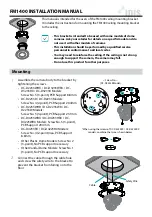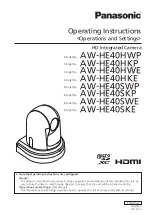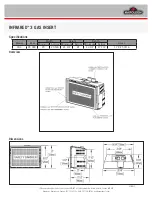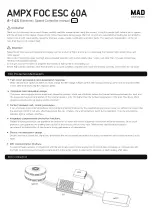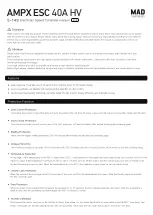
3
4. SAFETY (CONTINUED)
Anybody involved in handling or usage of the battery must completely understand
and be trained on all aspects of the battery systems as required by local laws and
regulations.
The battery is an electrical storage system. During operation and charging the DC
voltage will be 19.6 to 29.4, 28.0 to 42.0 or 39.2 to 58.8 volts for the 24V, 36V and 48V
batteries respectively.
In case the battery shuts down with a message that indicates “Battery Lockout”
EnerSys
®
must be contacted for service as the pack is locked out until a service person
is able to inspect the battery and then return it to EnerSys Service.
The main potential dangers of this battery are:
Thermal Events
: An event with high temperatures within the cell(s) which can possibly
include release of flammable, corrosive and toxic liquids/gasses, smoke containing
components such as hydrofluoric acid and carbon monoxide. Avoid prolonged exposure.
In case of fire, Refer to Section 7: Fire Extinguishing.
Short Circuits with Arc
: A shorting event with a high current may occur because of the
low internal resistance of the Li-ion battery. A resulting arc flash may emit an intense hot
flash of infrared, visible and ultraviolet light. Molten and vaporized metal may be ejected.
Components may become extremely hot.
Mechanical Hazards
: An event with dropping, crushing, pinching or impact due to the
heavy weight of the battery if improperly handled or restrained.
The battery features design-specific mechanical, electrical, and electronic / software
based provisions to minimize any expected risks.
These measures include:
• A functional safety qualified electronic monitoring and control system to ensure safe
electrical operation (voltage, current and temperature limits).
• A safe shut-off strategy to respond if limits have been violated (voltage, current and
temperature).
• Contactor and fusing strategy to minimize the impact of external short circuits on the
battery. However, arcing cannot be prevented in the most extreme cases.
• Dedicated handling / lifting points.
• Dedicated venting solution to respond to potential cell failure in order to mitigate the
impacts of the resulting outgassing.
To ensure safety, follow the safety guidelines below:
• Operation must only be done in accordance to the limitations within this document.
• Stop the usage of the battery if there is a crush, pinch, cut or other damage to the
power cables or power connectors.
• Keep the battery away from heat sources.
• Keep the battery away from ignition sources.
• Do not operate the battery in a hazardous location, such as a flammable or explosive
environment.
• Store only in monitored areas with suitable fire control and protection per local
requirements, e.g. local fire regulation and building insurance requirements.
• Operate only in monitored areas with suitable fire control and protection per local
requirements, e.g. local fire regulation and building insurance requirements.
• Operation must only utilize EnerSys qualified hardware and software as delivered and
installed by EnerSys personnel (no customizations are allowed).
• Charging must only be performed with EnerSys approved chargers for NexSys
®
iON
batteries.
• Handling and storage must be in a dry environment.
• Prevent immersion of the battery into water.
• Handling and service of the battery requires proper training of EnerSys approved
technicians with appropriate rated tools and Personal Protective Equipment (PPE).
• In the case in which the battery has been operated or store outside of the allowable
limits as stated in the document, cease operation and contact EnerSys.
• In the case of any error that cannot be reset, do not continue operation of the battery
until support and direction is provided by EnerSys.
The EnerSys NexSys iON battery is a sealed product, however in case of cell damage
within the battery, there is still the chance of electrolyte leakage. Please follow the
directions below if any of the following incidents take place. Additional information can
be found in the Lithium-ion Battery (Module) Safety Data Sheet (SDS): 829515.
4. SAFETY (CONTINUED)
• If leaked electrolyte comes into contact with a person’s skin or eyes, rinse the
affected areas with clean water for at least 15 minutes. In the event of any bodily
contact with electrolyte (either to the skin and/or eyes, and/or inhalation), seek
immediate medical attention.
• If leaked electrolyte comes into contact with the mouth, or is swallowed, rinse out
the mouth as well as the area around the mouth. Seek immediate medical attention.
• If thermal burns are caused, treat them accordingly. Seek immediate medical
attention.
5. USAGE
The NexSys iON battery must be used, operated and serviced in accordance with
these operating instructions. The operating instructions of the truck and battery charger
are required to be respected in addition to these operating instructions. In case the
permissible operation parameters of the industrial truck are stricter, the truck limits must
be respected for usage. For example, the permissible range of the battery application
temperature does not increase the permissible range of the truck’s application
temperature.
When the battery is installed into the truck, the traction connector of the battery has to
remain connected to the truck at all times. Never charge via the traction connector. For
charging, the charging plug(s) single or dual must be connected to the EnerSys approved
charger. Upon plugging in the first charge plug, the traction contactor is opened so that
the industrial truck cannot be operated inadvertently. For charging instructions, refer to
Section 17: Charging Battery.
In the event of discharging below the usable energy, resulting in the battery shutting
down due to low SOC, there is a feature to allow the truck to be operated on a very
limited capacity and performance in order to immediately return to a matching charger.
When a low SOC related tripping of the battery occurs, a restart (same as turning the
pack on) is allowed to reset the pack once. Refer to Section 14: Operator Interfaces. If
the battery is not placed on charge as soon as possible and allowed to discharge this
limited capacity, the battery will once again shut down.
This time it will be locked out
and require a service visit
. This limited capacity is intended to only allow for the truck
to be driven a limited distance and not be used for any lifts.
Opportunity charging is highly recommended in order to maximize the daily runtime
capability of the battery. It will also optimize the service life of the battery by decreasing
the discharge window of the battery during discharge.
Operating the NexSys iON battery in partial SOC is acceptable and beneficial for the
lifetime of the battery.
The battery temperature has an effect on the capacity of the battery. For example,
runtime may be reduced at lower temperatures.
Battery temperatures at extreme ends of the temperature limits as stated in this manual
will have an effect on performance, possibly resulting in an unexpected shutdown.
All visual and audible warnings are to be respected and reviewed (Refer to Section 23:
Troubleshooting).
The battery will go into a hibernation mode after a default of 8h when there is less than
a default of 3A current draw. It can be reactivated by restarting the battery by the various
start methods (Refer to Section 14: Operator Interfaces).
6. SAFETY VENTING
In the case of a thermal event, the battery is specially designed with a venting aperture
to ensure any hot gases are vented AWAY FROM THE OPERATOR in a safe manner.
7. FIRE EXTINGUISHING AND EMERGENCY RESPONSE
In the unlikely event of a thermal runaway, which may result in a visible release of gas
and/or intensive smoke build-up from the battery,
evacuate the location immediately
and contact Emergency Responsers
. If there is an irritation of the respiratory tract,
seek immediate medical attention.
Firefighting operations must be performed based on guidance provided in the Lithium-
ion Battery (Module) SDS: 829515 by trained firefighters with full
personal protective
equipment
and self-contained breathing apparatus. Ensure that emergency responders
are informed that the battery has Lithium-ion chemistry. Any indication of a thermal
event (gas, heat, vapors or smoke) requires fire suppression methods to be applied.
Absence of flame is not sufficient to consider the thermal runaway event stopped
or extinguished.
Large amounts of spray water and/or complete immersion into water can be used
effectively to cool the battery and contain a Li-ion battery thermal event.
Содержание NexSys
Страница 1: ...Owner s Manual www enersys com ADVANCED LITHIUM ION TECHNOLOGY Li ion TECHNOLOGY...
Страница 11: ...11 NOTES...













